



Axiomatic one, the reversed lottery strategy also known as LIE elimination was first presented on this Web page: Lotto, Lottery Strategy in Reverse: Not-to-Win Leads to Not-to-Lose or WIN. The idea crossed my mind in the 1990s. There are several versions of the Reversed Lottery Strategy, one of the latest being presented here: Dedicated LIE Elimination: Lottery, Lotto Strategy in Reverse for Pairs, Number Frequency.
Dedicated LIE Elimination, however, generates combinations to be played directly, without feeding them to the LIE feature in the Bright generators. Meanwhile, the reversed strategy presented in this very e-book is a purely reversed system: The combinations generated must be fed to the Bright output generators.
In discussions in my former forums, users of my software and I noticed important facts regarding the repeat of static filters. The skips, decades, last digits, and the 3-group frequencies are good candidates for the LIE option (reversed lottery strategy). Look at the reports created by SkipDecaFreq*. You will notice that the strings in a particular lottery drawing are no repeats from several previous draws. Well, then, generate lotto combinations using skips, decades, last digits, and the 3-group frequencies as filters. You know it is very rare for the output file to register 5, even 4, winning lotto numbers in the very next drawing. The same is true about the odd even O E, and low high L H lotto numbers. Only the skips are dynamic filters and they certainly behave very differently from the static ones.
Users of my software applied the LIE strategy manually for years and years and years. However, they didn't know what levels the filters reached. They counted manually how many drawings the same strings elapsed between hits. They didn't see a repeat of this decade string in the last 20-30 lottery drawings: 1 0 4 0 1. So, they would generate combinations for, say, the last 20 decade strings (groups of decades) one string at a time. The user would concatenate all outputs to one LIE file and feed it to the LIE feature in the Bright combination generators.
The process was obviously tedious and not very accurate. Thusly, I wrote specialized software in the year of grace 2014. The software has the LieStrings radix in the program name. The software generates first the very necessary reports to aid the user in selecting filter values. The software generates combinations in one batch: The output files are concatenated in the background and also purged of duplicates. The resulting LIE files are fed to the LIE feature in the Bright combination generators. Despite my serious efforts, I wasn't able to create the same type of software as for the Dedicated LIE Elimination: Lottery, Lotto Strategy in Reverse for Pairs, Number Frequency.
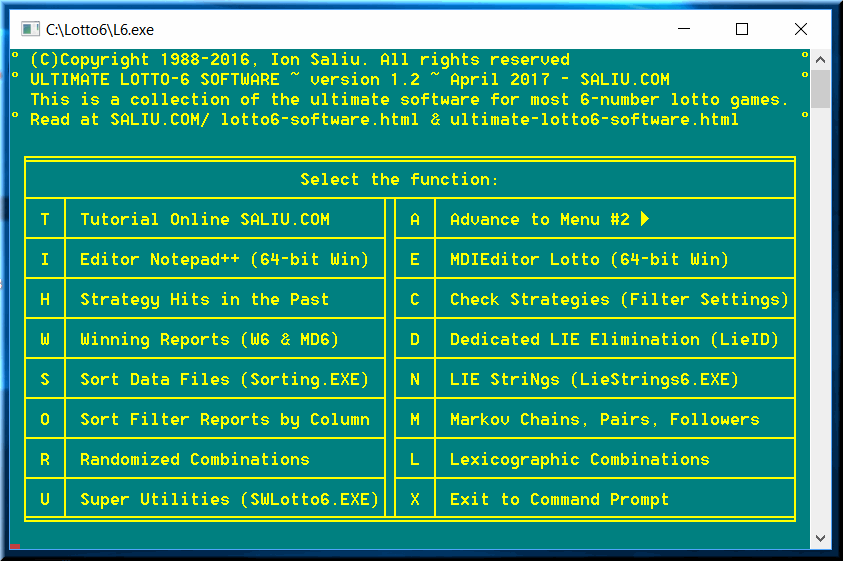
The parameters in this type of software for reversed lottery strategy have unique behavior. Yet, I put them together in the same program instead of writing separate programs for decades, separate programs for last digits, etc. There is, however, a common function for strategy checking (all reports in one batch) and a common function for sorting the reports by column. The combinations are generated by separate modules as presented in the software menus.
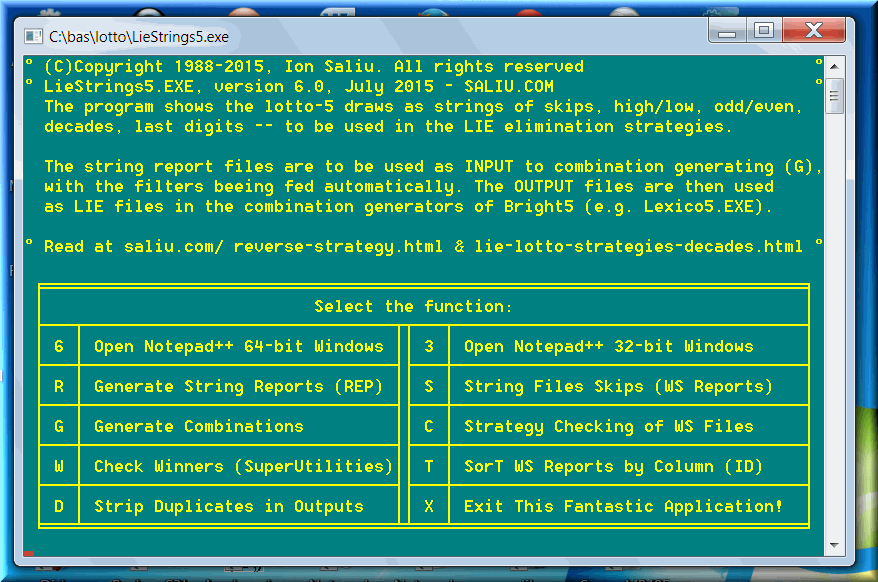
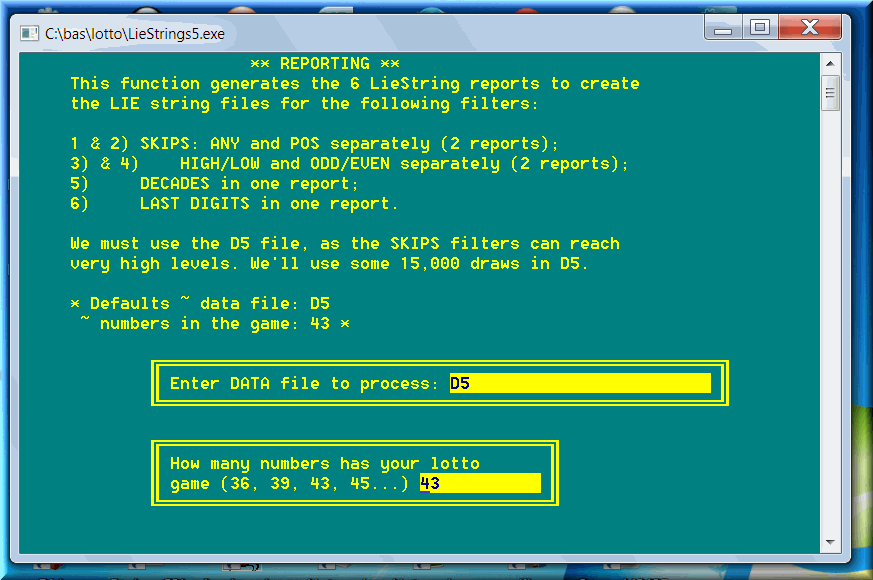
The software in this category generates 6 reports, for each type of filter.

The figures in line #1 translated: lotto #1 in the lotto-5 draw skipped 1 drawing; lotto #2 in the draw skipped 0 drawings (i.e. hit in 2 consecutive drawings); lotto #3 in the draw skipped 1 drawing; lotto #4 in the draw skipped 3 lottery drawings; lotto #5 in the draw skipped 6 drawings (i.e. hit in draw #8: 8 1 1 = 6).
The figures in line #1 interpreted: lotto #1 in the lotto-5 draw skipped 1 drawing; lotto #2 in the draw skipped 24 drawings (i.e. hit in draw #26: 26 1 1 = 24); lotto #3 in the draw skipped 94 drawings; lotto #4 in the draw skipped 3 lottery drawings; lotto #5 in the draw skipped 23 drawings.
Translation of the figures in line #1: lotto #1 in the lotto-5 draw was low; lotto #2 in the draw was low; lotto #3 in the draw was low; lotto #4 in the draw was high; lotto #5 in the draw was high.
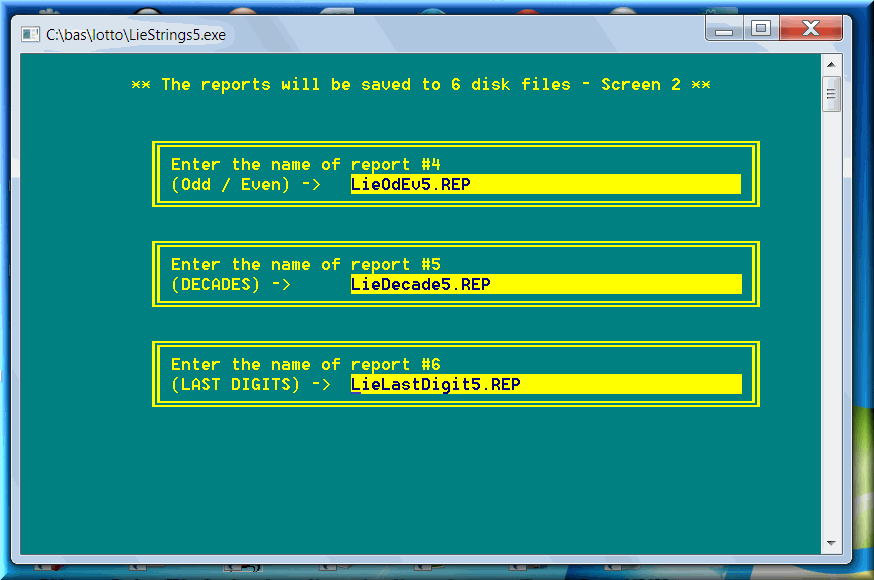
Interpretation of the figures in line #1: lotto #1 in the lotto-5 draw was even; lotto #2 in the draw was odd; lotto #3 in the draw was even; lotto #4 in the draw was odd; lotto #5 in the draw was even.
Translation of the figures in line #1: lotto #1 in the draw was from decade #2 (10 19); lotto #2 in the draw was from decade #2 (10 19); lotto #3 in the draw was from decade #2 (10 19); lotto #4 in the draw was from decade #4 (30 39); lotto #5 in the draw was from decade #4 (30 39).
Interpretation of the figures in line #1: lotto #1 in the draw had 2 as last digit; lotto #2 in the draw had 3 as last digit; lotto #3 in the draw had 4 as last digit; lotto #4 in the draw had 1 as last digit; lotto #5 in the draw had 2 as last digit.

You select, however, how many filter lines (strings) to use inspired by the WS reports you studied. For example, you use one line from the odd even report file LieOdEv5.REP: 2 1 2 1 2. The software generates correctly the 5/43 lotto combosnations: 33649. (I decided to use the term combosnations for lottery combinations that should not be played, that should be eliminated beforehand.) It is very rare for such a decade string of filter values to repeat in the very next drawing. Thus, for a vast majority of cases those 33649 combosnations are wasteful (oops... tautology!)
There are situations when the ID5, even the ID4, filters reach very high values in the WS reports. It is therefore recommended to run the R = Report function for thousands of combinations at least in the first run. Then, sort the reports by column (function T = SorT WS Reports by Column) to see the highest filter values at the top. You'll get an adequate picture of what to expect in subsequent report runs.
* WS LIE Report for DECADES *
* Analyzed: 1000 of 2000 lines
Line Decades Decades Decades
no. ID3 ID4 ID5
209 0 33 1791
428 9 473 1572
497 3 23 1503
281 1 106 1479
592 27 74 1408
...
* WS LIE Report for LAST DIGITS *
* Analyzed: 2500 of 5000 lines
Line LastDig LastDig LastDig
no. ID3 ID4 ID5
1 29 925 4999
2 43 183 4998
4 243 4996 4996
6 30 1886 4994
7 11 666 4993
...
958 105 3383 191
889 28 161 187
1176 100 3824 161
851 69 2074 155
439 61 2033 147
1114 137 1822 141
332 35 3253 141
2042 21 264 134
2123 7 317 126
40 69 3339 117
1634 156 484 44
You notice that the exact last digit strings of filter levels do NOT repeat even in 5000 drawings! Only in 11 drawings out of 2500, LastDig ID5 repeated after fewer than 200 draws. The last digits offer the most sure-fire reversed lotto strategy. The players waste serious money by playing lottery combosnations!
This is your thinking when the generating modules present you with the prompt How many LINES to use.

* WS LIE Report for ANY_MIN *
* File: LieAny5.REP
* Analyzed: 2500 of 5000 lines
Line Any_Min Any_Min Any_Min
no. ID3 ID4 ID5
1 1 2 0
2 3 8 674
3 0 2 4
4 0 3 50
5 0 9 2
...
* WS LIE Report for DECADES *
* File: LieDecade5.REP
Line Decades Decades Decades
no. ID3 ID4 ID5
1 2 55 21
2 0 6 2
3 1 77 72
4 5 2 32
5 0 3 99
6 0 22 18
7 3 2 18
The LieStrings software applications generate a second type of reports necessary to select filter values (construct strategies). Function: S = String Files Skips (WS Reports). This function needs the 6 reports (REP files) created by the R = Generate String Reports fixture. The WS reporting will generate 8 reports, as the ANY and POS (skips) have separate reports for the minimum and maximum levels.

* WS LIE Report for ANY_MIN *
* File: LieAny5.REP
* Analyzed: 2500 of 5000 lines
Line Any_Min Any_Min Any_Min
no. ID3 ID4 ID5
1 1 2 0
2 3 8 674
3 0 2 4
4 0 3 50
5 0 9 2
6 1 120 4994
...
* WS LIE Report for ANY_MAX *
* File: LieAny5.REP
* Analyzed: 2500 of 5000 lines
Line Any_Max Any_Max Any_Max
no. ID3 ID4 ID5
1 10 1196 4999
2 0 2 19
3 18 4997 4997
4 5 8 153
5 4 7 1289
...
* WS LIE Report for POS_MIN *
* File: LiePos5.REP
* Analyzed: 2500 of 5000 lines
Line Pos_Min Pos_Min Pos_Min
no. ID3 ID4 ID5
1 3 4 6
2 1 0 3
3 0 2 147
4 0 38 587
5 10 0 121
6 1 135 4994
...
* WS LIE Report for POS_MAX *
* File: LiePos5.REP
* Analyzed: 2500 of 5000 lines
Line Pos_Max Pos_Max Pos_Max
no. ID3 ID4 ID5
1 0 46 560
2 19 11 284
3 1 10 235
4 2 5 78
5 1 7 8
6 10 2 0
7 4 85 1407
...
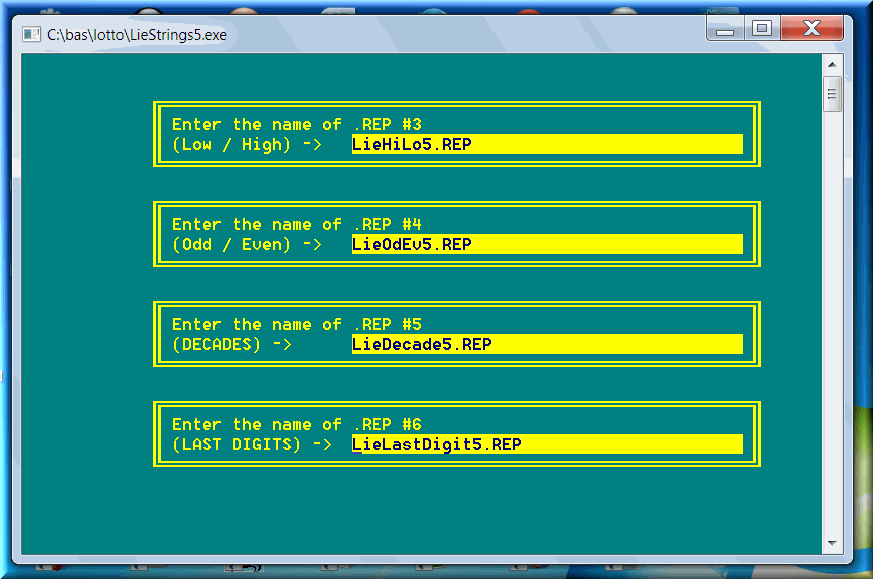
* WS LIE Report for HIGH / LOW *
* File: LieHiLo5.REP
* Analyzed: 2500 of 5000 lines
Line L / H L / H L / H
no. ID3 ID4 ID5
1 0 2 1
2 0 4 2
3 1 0 4
4 2 3 7
5 2 1 0
6 1 0 20
...
* WS LIE Report for ODD / EVEN *
* File: LieOdEv5.REP
* Analyzed: 2500 of 5000 lines
Line O / E O / E O / E
no. ID3 ID4 ID5
1 5 3 56
2 3 0 75
3 0 14 80
4 2 1 12
5 0 14 25
...
* WS LIE Report for DECADES *
* File: LieDecade5.REP
* Analyzed: 2500 of 5000 lines
Line Decades Decades Decades
no. ID3 ID4 ID5
1 2 55 21
2 0 6 2
3 1 77 72
4 5 2 32
5 0 3 99
...
* WS LIE Report for LAST DIGITS *
* File: LieLastDigit5.REP
* Analyzed: 2500 of 5000 lines
Line LastDig LastDig LastDig
no. ID3 ID4 ID5
1 29 925 4999
2 43 183 4998
3 74 14 354
4 243 4996 4996
5 196 1545 4208
6 30 1886 4994
...
As you learnt in Chapter 3, the software has a very useful function to aid the user in finding strategies: T = SorT Filter Reports by Column. The module will sort the 8 WS reports by any column. The columns are sorted in descending order, so that the highest filter values come up at the top.
The main goal is to find high levels for the respective filter(s). The higher the value of a filter, the more combinations eliminated. All lottery strategies usually start with one filter (column) I name the pivot filter. We then look for other high values in the columns of the same report. Do NOT use the ANY or POS parameters as pivot filters you saw the reason.
We want to see how often a strategy with those parameters hit in the past. We want to see what other reliable filter values we can employ additionally. There is another valuable function that does exactly that: C = Strategy Checking of WS Files. The useful strategy program compiles a report like this one (only a fragment here):
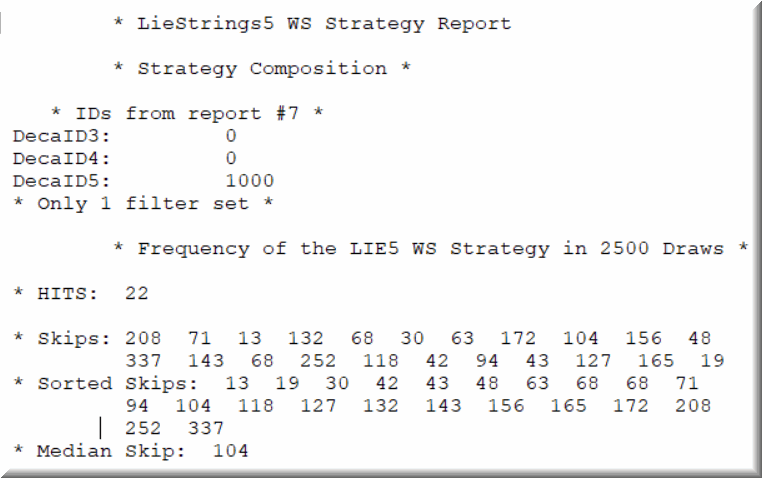
We can see high filter values in other columns, especially the last digit report LieLastDigit5.WS. Furthermore, we can correlate this strategy with other types of strategies in those great pieces of software known as Bright and Ultimate Lottery Software. The functionality is presented in-depth on this e-book: Cross-Reference Lottery Strategy Files Created by Command Prompt Software and MDIEditor Lotto WE. The function is available from the second menu of the Ultimate Lottery Software integrated software: T = Cross-Checking Strategies.
In the spring of 2014, my website experienced a difficult legal challenge. My entire site was taken down as a result of bogus complaints on the grounds of copyright infringements. Threatening emails sent to me unwarrantedly were considered copyrighted materials as if published Web pages or books! There are plenty of details starting in the Forums link in the footer. This type of lottery software was under development during that harsh time. My lottery forums closed for good because of that incident of law abuse. Before the shutdown, however, I had come up with a quick lotto strategy and posted it my forum.
I worked first with ID3 for the Skips_ANY_Min filters. I chose a conservative value: ID3 = 3; it occurs quite frequently. The program generated an output LIE file of some 50000+ combosnations. I fed that LIE file (created by the ID3 = 3 filter) to Lexico5 with no other filters enabled. The final output had 61982 lines (amount to play).
I checked for winners in Super Utilities for the top 12 lottery drawings (excluded from the LIE processing). There were plenty of winners as much as making a profit! Evidently, random play was badly beaten; also, the house edge was badly beaten. Here is the fragment that matters.
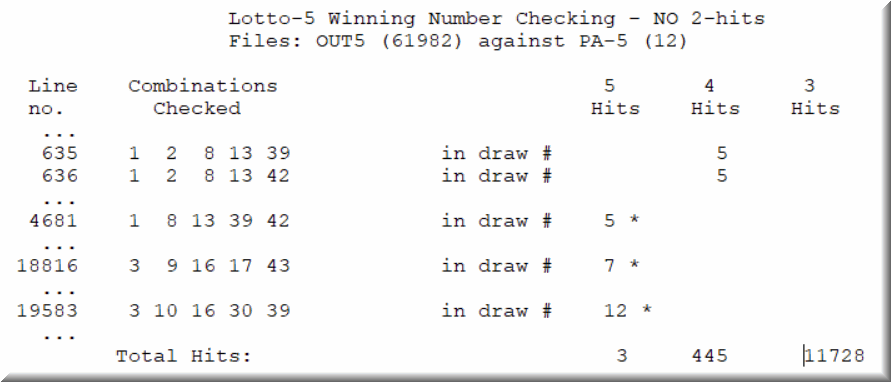
I went to the Pennsylvania Lottery Web site to check past jackpot amounts for the 5/43 lotto game.
01/22/14 Winning Numbers: 05 11 15 39 40
0 players matched 5, jackpot rolls to $325,000.00
47 players matched 4, each receiving $302.50
1,899 players matched 3, each receiving $12.50
25,577 players matched 2, each receiving $1.00
01/21/14 Winning Numbers: 06 11 12 15 31
0 players matched 5, jackpot rolls to $225,000.00
48 players matched 4, each receiving $225.00
2,137 players matched 3, each receiving $8.50
23,474 players matched 2, each receiving $1.00
01/20/14 Winning Numbers: 09 19 24 30 42
1 players matched 5, each receiving $1,000,000.00
163 players matched 4, each receiving $273.00
6,618 players matched 3, each receiving $11.00
80,034 players matched 2, each receiving $1.00
Jackpot average: (325,000 + 225,000 + 1,000,000) / 3 = 516,667
'4 of 5' average: (302.50 + 225.00 + 273) / 3 = 267
'3 of 5' average: (12.50 + 8.50 + 11.00) / 3 = 10.67
I disregarded the 2 of 5 "fixed" prize of $1... although it totaled over $100,000!
Total cost: 61982 * 12 = 743,784
Total in prizes: ( 3 * 516,667) + (445 * 267) + (11,728 * 10.67) = 1,838,457
Net profit: over 1 million
I had only expected 1 jackpot hit the other two 5 of 5 hits were extras. I don't know exactly how that happens, except that ID3 were also 3+ in those two instances. I checked also for other ID3s and one ID4 (Low/High & Odd/Even). The same thing occurs. There are multiple hits in the ranges that act as future lottery drawings. A better method would be combination-generating in the traditional manner of Bright software; then purge the outcome by enabling LIE files.
7. Resources in Lottery Lotto Software, Strategies, Systems

